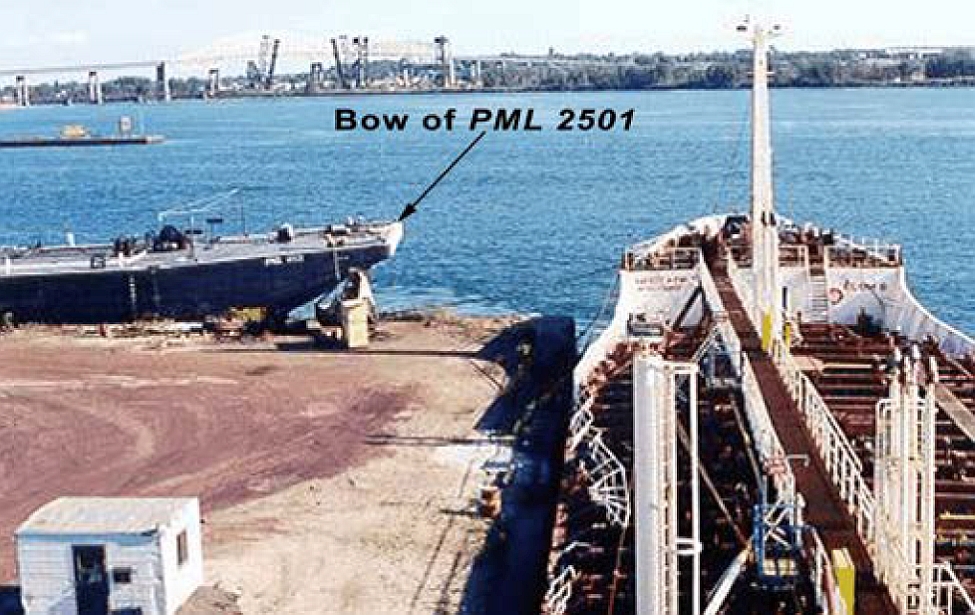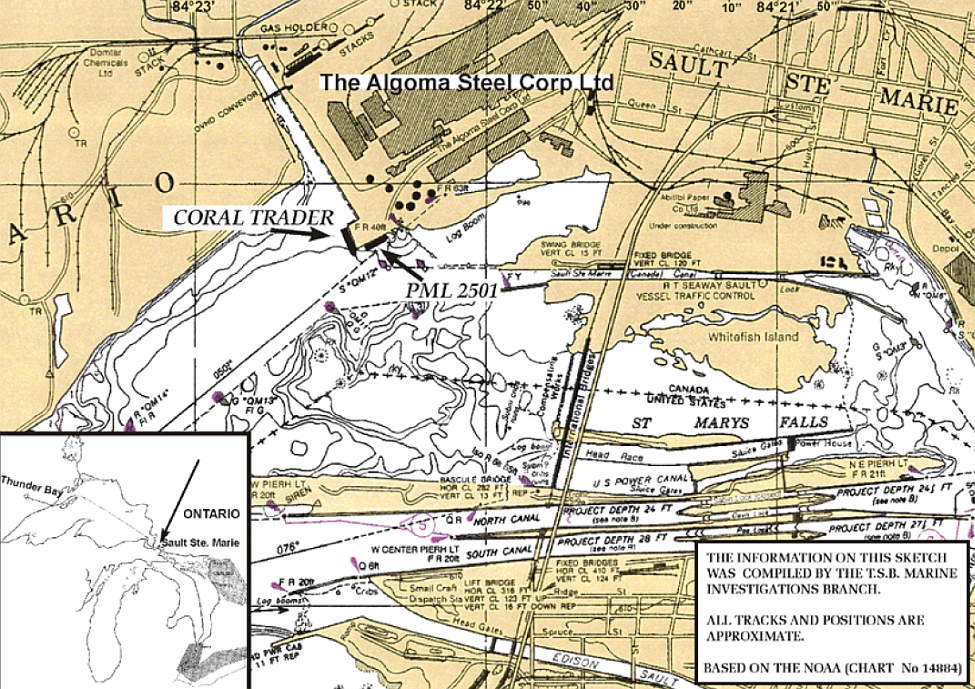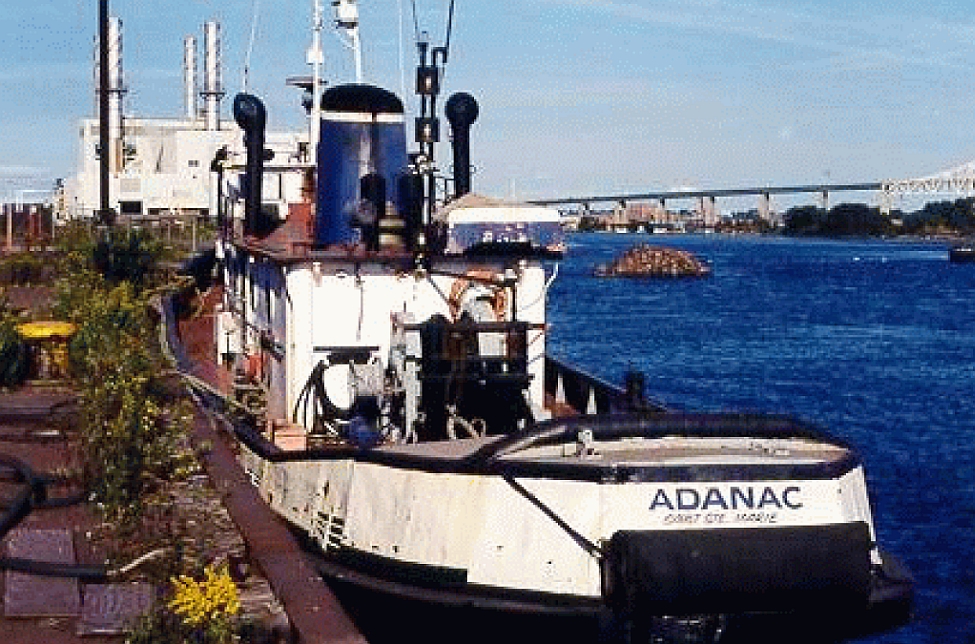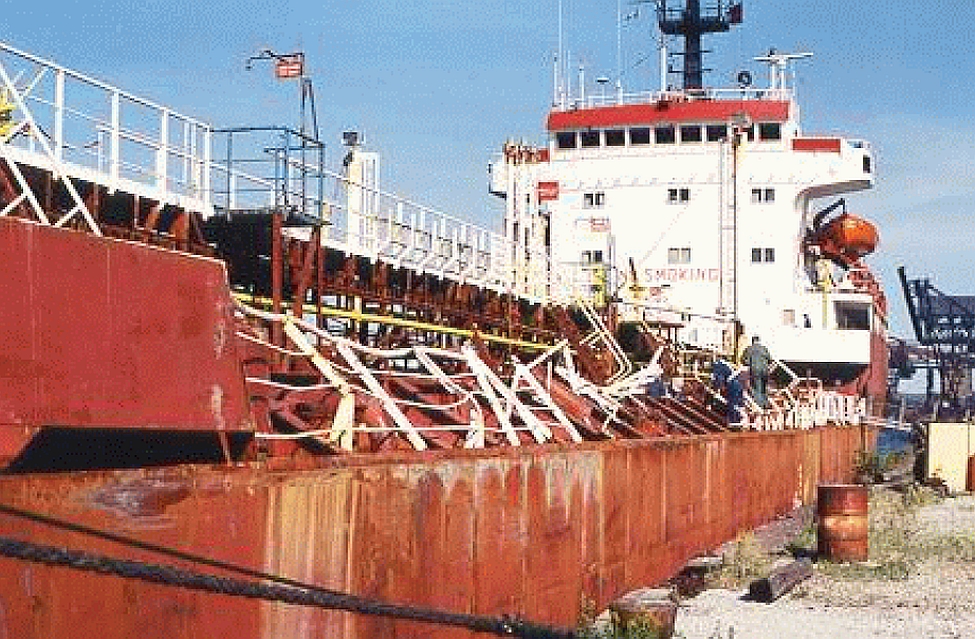Striking of tank barge PML 2501
by chemical tanker Coral Trader
Algoma Steel Corporation Wharf
Sault Ste. Marie, Ontario
The Transportation Safety Board of Canada (TSB) investigated this occurrence for the purpose of advancing transportation safety. It is not the function of the Board to assign fault or determine civil or criminal liability. This report is not created for use in the context of legal, disciplinary or other proceedings. See Ownership and use of content. Masculine pronouns and position titles may be used to signify all genders to comply with the Canadian Transportation Accident Investigation and Safety Board Act (S.C. 1989, c. 3).
Summary
In the late evening of 22 August 2001, the loaded tanker Coral Trader with a U.S. pilot on board departed the Algoma Steel Corporation wharf at Sault Ste. Marie, Ontario with tug assistance, when it struck the port bow of the moored tank barge PML 2501.
The Coral Trader sustained moderate damage, but caused no pollution. No one was injured.
Factual information
Particulars of the vessels
| Name | Coral Trader | PML 2501 |
|---|---|---|
| Official number | 9599 | 818823 |
| Port of registry | Monrovia, Liberia | Sault Ste. Marie, Ontario |
| Flag | Liberia | Canada |
| Type | Chemical Tanker | Petroleum Tank Barge |
| Gross tonnage | 4143 | 1954 |
| LengthFootnote 1 | 104.61 m | 85.23 m |
| Draught | 5.94 | |
| Built | 1974 | 1980, rebuilt in 1996 |
| Propulsion | Diesel 6803 BHP at 600 RPM | nil |
| Crew | 18 | nil |
| Passengers | 1 | nil |
| Registered owner | T. Alendal Rederi AS (Norway) | Purvis Marine Ltd. (Sault Ste. Marie, Ontario) |
Description of the vessels
The Coral Trader is an ocean-going chemical tanker with its bridge, accommodation and machinery located aft of its cargo tanks. It is fitted with a single rudder and its main engine drives a controllable-pitch, left-handed propeller. The vessel was moored in a southerly direction along the western side and southern limit of the Algoma Steel Corporation wharf. Its intended voyage was downbound through the "Soo Locks" with a cargo of coal tar in its centre tanks. The empty side tanks, together with the continuous double bottom, provide double hull environmental protection.
The PML 2501 is a square-ended, non-propelled petroleum tank barge of steel construction. It was moored in a westerly direction along the southern end of the Algoma Steel Corporation wharf (see Photo 1).
Sault Ste. Marie - Area of the occurrence
The harbour of Sault Ste. Marie, Ontario is located on the St. Marys River, which is the outlet of Lake Superior, connecting it with Lake Huron. The river is bounded to the north and east by the province of Ontario, and to the south and west by the state of Michigan, United States. The Algoma Steel Corporation wharf is at the north western side of the canal systems which by-pass the St. Marys Falls. The tanker Coral Trader and the barge PML 2501 were berthed at this wharf (see Figure 1).
The Sault Ste. Marie (Canada) Canal which passes north of the St. Marys Falls is closed to through navigation. All vessels must utilize the St. Marys Falls Canal and its lock systems (Soo Locks) in United States territory south of the St. Marys Falls. The St. Marys River waterway is within International District No. 3 which is a compulsory pilotage area. Every foreign trade vessel must engage a United States or Canadian Registered pilot for the route being navigated within this area of the Great Lakes. There are 19 U.S. pilots and 4 Canadian pilots assigned to the district.
Vessel traffic services are provided by the United States Coast Guard. All salt water vessels transiting the lock systems along the St. Marys River which are not equipped with either bow thruster or stern thrusters, are required to be assisted by one or more tugs to ensure that full control of the vessel is maintained at all times.Footnote 2
Occurrence
On the evening of 22 August 2001, the Coral Trader was berthed port side to the Algoma Steel Corporation wharf and headed south toward the St. Marys River. Its bow protruded approximately 15 to 20 m past the end of the wharf, exposing its starboard side to a strong easterly current of 3.0 to 3.5 knots.
The barge PML 2501 was berthed on the southern side of the wharf and headed west with its square bow approximately 7 to 8 m from the outer knuckle of the wharf.
At 2308, the Coral Trader had finished loading coal tar and was ready to leave. A U.S. pilot had been aboard for approximately 45 minutes and had made himself familiar with the vessel's manoeuvring characteristics from the pilot card. He had discussed the intended departure with the master of the assisting tug Adanac (see Photo 2). However, the tug master indicated that he only received a brief VHF radio communication from the pilot concerning the manoeuvres required for departure, but no formal departure plan was made. The master of the Coral Trader indicated that there was a very brief discussion with the pilot concerning the vessel's departure, however, a departure plan was not prepared.
The pilot had taken an average of four or five vessels per season to and from various berths along the Algoma wharf. However, this was his first pilotage assignment from this particular berth at the extreme southern limit of the wharf. He did not fully appreciate the speed of the river current around this end section of the wharf. At the time of departure, the Adanac was positioned forward to push on the bow and port shoulder of the Coral Trader at about 75° to the tanker's line of direction. There was little room for the tug to manoeuvre between the bow of the barge PML 2501, the wharf knuckle, and the forward end of the Coral Trader.
At 2309, in darkness, clear visibility and calm conditions, the Coral Trader's mooring lines were let go and the tug Adanac began to push ahead on the tanker's port shoulder. The initial engine control order for the Coral Trader was "dead slow astern", and the vessel moved astern approximately 3 m while the tug pushed the vessel's bow about 6 m out from the wharf.
At 2311, the engines were set to "dead slow ahead". Reportedly, the master had difficulty in hearing the instructions given by the pilot, who was speaking in a low voice.
At 2312, the pilot gave the engine order "stop" then "half astern".
At about 2314, the tug circled around the starboard quarter of the Coral Trader towards the tanker's stern. Meanwhile, the current swung the Coral Trader's bow back to the wharf. The tug attempted to connect a towline, stern to stern, but the Coral Trader was moving slowly ahead along the side of the wharf. Turbulence from the tanker's propeller prevented the tug's stern from closing quickly enough to pass a connecting towline, but it was eventually secured. The bridge wings were used by both pilot and master to get a good view astern during manoeuvres.
At 2316, the main engine was stopped after the tanker had moved approximately 33 m ahead. However, the Coral Trader continued to move ahead and further into the cross current. When the vessel was approximately half its length beyond the end of the wharf, the bow began to fall away to port with the current. The master expressed his concerns to the pilot regarding conduct of the vessel movement, as the distance between the barge PML 2501 and the Coral Trader began to close rapidly. The master of the Coral Trader informed the pilot that "full astern" movement was necessary.
The engine manoeuvring log showed that at 2319 a "slow astern" instruction had been made, followed by "stop" at 2320.
At 2323, "full astern" order was given. The Coral Trader's forward momentum carried it ahead until about 75 percent of the vessel passed beyond the end of the wharf. The corner of the wharf acted as a pivot point and the vessel continued to swing to port with the current. The vessel struck the barge PML 2501. The front of the accommodation superstructure (port side, just above deck level) of the moving tanker caught the port bow corner of the barge, pushing the barge astern and breaking some of its mooring lines. As the "full astern" control setting took effect, the Coral Trader with tug assist, began backing towards its original berthing location.
The remaining barge mooring lines returned the PML 2501 forward of her original berthing position as the Coral Trader moved astern, but the fore end of the barge was eventually pushed tight against the wharf.
At approximately 2340, the Coral Trader's port side made contact with the port corner of the barge's bow. In continuing its astern manoeuvre while sideswiping the corner of the static barge, the Coral Trader suffered damage to its railings, manifold fittings and vents along the port side of the open deck (see Photo 3).
At 0005 on 23 August, the Coral Trader was secured to its previous moorings at the Algoma wharf.
The normal method of departure from this berth is to use a backspring aft and tug assistance forward to prevent the bow from setting onto the wharf.
Analysis
Pilotage
Compulsory pilotage areas are established to enhance operational safety and to protect the environment from marine accidents. Pilots provide local knowledge of the prevailing navigation conditions in the area. The pilot is responsible to the master solely for the safe navigation of the vessel. The master retains overall responsibility for the safety of the vessel but relies on the pilot's local knowledge and ability to handle the vessel in a safe and efficient manner.
Since the master has to rely on the pilot's in-depth local knowledge, it is essential that pilots have all pertinent navigational information for the intended passage before assuming conduct of the vessel.
Voyage planning
A well-planned voyage and continuous monitoring and updating is crucial to ensure safe navigation. Transport Canada's Recommended Code of Nautical Procedures and Practices (TP 1018) states that "the intended voyage shall be planned in advance taking into consideration all pertinent information and any course laid down shall be checked before the voyage commences."Footnote 3 The need for voyage planning and passage planning applies to all vessels. International Maritime Organization (IMO) voyage planning requirements also state that "the planned route shall be clearly displayed on appropriate charts, and shall be continuously available. . . ."Footnote 4 The IMO's Guidelines for Voyage Planning provide further details on the development of voyage plan.Footnote 5
Limitations imposed by navigational practices
The pilot had handled vessels at various berths along the Algoma Steel Corporation wharf for many years, except the one at its extreme southern end. The master of the Coral Trader was aware of this but reportedly he was confident that the pilot would safely carry out the assignment.
Minimum power applications for the majority of the ahead/astern control settings had little effect on keeping the Coral Trader free from the dangers presented by the proximity of PML 2501, and the strength and direction of the river current as the vessel departed.
In this instance, a spring line astern, normally used for this manoeuvre, was not used. Consequently, full control over the manoeuvre could not be retained and the vessel's bow was moved some 6 m off the wharf - a distance insufficient to permit the vessel to be turned upstream. As there was insufficient space to use the tug to advantage on the port side, the tug was prematurely moved aft.
When the vessel moved ahead, the greater segment of the vessel was exposed to the force of current. With no tug forward to hold the bow, the vessel soon succumbed to the force of current and the vessel drifted onto the barge PML 2501. This would suggest that the pilot underestimated the strength of the current and that the manoeuvre was not carefully planned taking into consideration all of the elements. The loss of control over the vessel can be attributable to inadequate pre-departure planning which resulted in the spring line aft not being utilized and the tug not being used to full advantage.
Given the prevailing strong currents in the area and the pilot's apparent lack of experience at this wharf, good pilotage practices dictate that all pertinent information essential to safely undock and navigate the vessel ought to have been obtained prior to taking over the conduct of the vessel. Additionally, proper safeguards ought to have been instituted in the manoeuvre and emergency response considered. In essence, pre-departure passage planning would have provided an opportunity to the pilot to identify the shortcomings of the manoeuvre and institute measures to mitigate the risk.
This is not an isolated occurrence. In the grounding of the Raven Arrow,Footnote 6 the Board, concerned about the safety of vessels operating in Canadian waters, reiterated the need for implementation of TSB recommendation M95-08 which called for:
- an agreed-upon passage plan prior to the commencement of passage in pilotage waters, and
- to provide for a climate on the bridge where team members can comfortably provide input.
The report goes on to emphasize that, for masters to retain command of the vessel, they need to hold effective discussion with pilots.
Pilot/master rapport
Pilots and tug masters usually have established routines or methods for assisting vessels safely from berths at the Algoma wharf based on the successful conduct of previous pilotage assignments. The master of the Coral Trader had departed from this location twice before, when a different approach had been effectively used for undocking the vessel. Although the pilot indicated that this was his first assignment from this wharf, meaningful discussions outlining the details of the manoeuvre were not held. As the situation developed, the master's ability to retain command was compromised and he did not intervene quickly enough.
Communications
During vessel manoeuvring, very little communication took place between the pilot and the tug master or between the pilot and the vessel's officers. The pilot tried several times to contact the assisting tug, but his orders did not receive a proper acknowledgment from the tug master. It is unclear how the tug ended up at the stern of the vessel - whether it was pilot's directive, communications difficulty, or on the tug master's initiative. In any event, proper communication procedures were not carried out, which permitted the situation to go unnoticed for a period of time at a critical stage in the vessel's manoeuvre.
Effectiveness of bridge resource management
Navigation with a pilot on board creates a situation where the pilot is teamed with an existing crew to carry out a coordinated job. Generally, the pilot has the local navigational knowledge to analyze cues more readily and take rapid action as necessary, while the ship's crew has a greater understanding of the ship's handling characteristics. Since pilots, masters and officers of vessels have different realms of expertise and training, it is essential that the skills of each be combined in the working relationship of a bridge team.
In this instance, there was minimal bridge resource management between the vessel's bridge team and the pilot. The communications and manoeuvre monitoring were ineffective; neither the master nor the pilot had full appreciation of the developing dangerous situation which required sufficient action to safely manoeuvre the Coral Trader into the channel. As the pilot did not speak loudly enough with the tug, the master was unable to hear the pilot's communication. This precluded him from effectively monitoring the navigation of the vessel. On the other hand, the master did not inform the pilot to communicate in a manner that would be audible to the bridge team.
Findings
Findings as to causes and contributing factors
- This was the pilot's first assignment from this wharf and he did not fully appreciate the strength of the current in the area.
- The loss of control over the vessel can be attributed to inadequate pre-departure planning in that the spring line aft was not used and the tug was not used to full advantage.
- There was no agreed-upon passage plan before the departure of the vessel, resulting in a lost opportunity to identify the shortcomings of the manoeuvre and take measures to mitigate the risk.
- As meaningful discussions outlining the details of the manoeuvre were not held, the master's ability to intervene was compromised as the situation developed, resulting in the master not intervening quickly enough to try to extricate the vessel from a dangerous situation.
- Bridge resource management principles, including proper communication practices, were not put into practice.
This report concludes the Transportation Safety Board's investigation into this occurrence. Consequently, the Board authorized the release of this report on .
Appendices
Appendix A - Glossary
- BHP
- brake horsepower
- IMO
- International Maritime Organization
- m
- metre
- NOAA
- National Oceanic and Atmospheric Administration, United States
- PML
- Purvis Marine Ltd.
- RPM
- revolutions per minute
- STCW Code
- Seafarers' Training, Certification and Watchkeeping Code
- TP
- Transport Canada publication
- TSB
- Transportation Safety Board of Canada
- U.S.
- United States
- VHF
- very high frequency
- °
- degree



